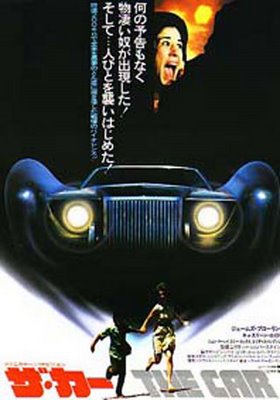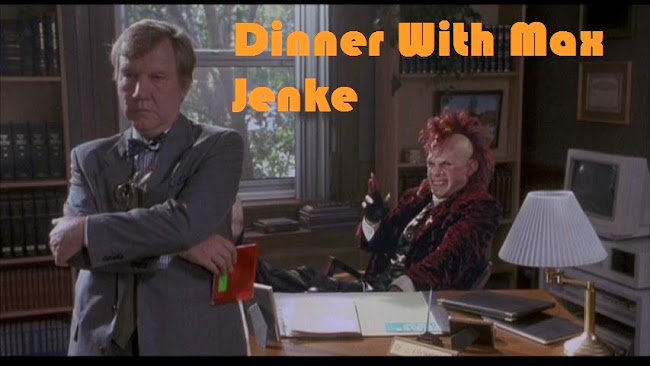
Steven Spielberg's acclaimed TV movie Duel (1971) is generally regarded as a haiku of road rage. But is Duel the tour de force that it's been made out to be? Does it really make the most of its premise? Well, yes in the sense that cat and mouse games don't come much more tense than Dennis Weaver's distraught efforts to keep his Plymouth Valiant ahead of the mysterious trucker who has a death wish out for him.
But as nerve-wracking a movie as it was, and as much of an Everyman that Weaver played, I always felt that Duel was the story of one chump's bad luck, with a cautionary note about truckers and proper road etiquette attached. It didn't do anything to scare me off the road, in other words. Instead it was another, much less lauded film, that made me forever wary of other vehicles - 1977's The Car. As far as my traumatized nine-year-old self was concerned, when the rubber met the road, The Car was by far the better drive than Duel.
A head-on collision between Duel and The Exorcist (the film opens with a quote by famed Satanist Anton le Vey), The Car was deemed a jalopy by most critics and fans at the time of its release, not fit for scrap metal. But I don't know a single kid who grew up in the '70s who doesn't have the blare of The Car's hell-spawned horn branded into their consciousness.
The tight-knit community of Santa Ynez is a quiet Utah town until the day a tank of a black sedan arrives and gets a taste of blood on its bumper by dispatching two carefree young bicyclers. From there, The Car proceeds to out-maneuver all efforts of the local law to stop it as it runs roughshod over as many hapless victims as it can. Can James Brolin as cycle-riding cop Wade Parent beat The Car with just his two wheels and a kick-ass moustache?
The scariest aspect to The Car is how The Car can strike at any time. You wouldn't think a black sedan could be so stealth but this one is. It can even get into your garage without you knowing about it. And even when you see it coming a mile away, you're just as dead. Duel was merely about a trucker chasing one panicky middle-aged dude for miles upon miles and then he even fails to scrub that one dude. If The Car could laugh at that, it would because The Car knows how to deliver a body count.
All the time, horror movies are referred to in terms of what they'll make you afraid to do once you seen them. You know, you'll never shower again, you'll never go to the beach, you'll never go in the woods - and so on. Well, The Car might be the only horror movie I can think of that literally gives you a reason to be scared to do anything. Don't bicycle, don't hitchhike, don't cross the street, don't drive, don't run, don't walk outside, don't stay in the house. Whatever you do, you're in a world of shit if The Car is around. You're just not safe, period. As a kid, this movie even made me scared to be sleeping on the second floor. Because I knew that the Car could easily bring the whole house down.
We never see who's behind the wheel of The Car, but director Elliot Silverstein and writers Michael Butler, Dennis Shryack, and Lane Slate don't give you a long list of suspects. The Car all but has a license plate that says HEL-666. Why the Devil would be driving a black sedan and running down, say, hitchhikers who play the French horn is unexplained but that just makes it scarier, right?
Even though its hard to upstage the Car itself, the cast of The Car is one of my favorites of the '70s with James Brolin, Ronny Cox, and R.G. Armstrong being the most recognized names. But I particularly love Brolin's onscreen squeeze, played by Kathleen Lloyd. As Lauren, the local school teacher, Lloyd was like every groovy grade school teacher I had during the '70s - from Ms. Metzeger to Mrs. Cosgriff.
She was a character I completely recognized from my own experiences. She was cool, she was funny, and she wasn't one of these sad characters you often see in movies that take place in small towns who are just itching to get out and start a real life. You know, you always felt that by staying in Bodega Bay that Suzanne Pleshette's school teacher Annie Hayworth in The Birds was consigning herself to an unfulfilled life. But that's not the case with Lauren. Santa Ynez is totally her town. And her and Brolin are definitely Santa Ynez's It Couple. Lloyd isn't just playing the disposable love interest here, she's one boss chick (major bonus points to Lloyd S. Papez, The Car's art director, for the inspired touch of including an oil painting of Wade that's clearly the work of Lauren's amateur hand among the objects in her house). So when Lauren is singled out for The Car's most personal attack, it really is a devastating shock. In a movie that doesn't lack for outrageous moments (like when The Car deliberately flips itself over at top speed to roll over two oncoming police cruisers at once - killing every officer on board), Lauren's close encounter with The Car is ultimate proof that The Car will not wait for its victims to meet it out in the streets. Instead it provides its own drive-thru service.
When Quentin Tarantino made Death Proof (2007) with the claim that it would be a slasher movie where the killer's weapon was a car, I figured he'd be looking to outdo - or at least compare with - the car-nage of The Car. But as it turned out, Death Proof amounted to little more than thirty seconds of Driver's Ed footage. When it comes to making a horror movie about a car, The Car is still the uncontested King of the Road. Over thirty years later, it still gets better mileage.
And in closing, a big honk of the horn to
Final Girl for inspiring this blog as part of her Film Club Day.













